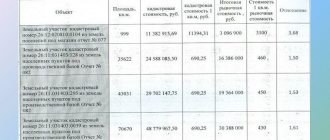Author of the article: Lina Smirnova Last modified: January 2021 5439
Every person at a certain stage of life begins to think about who he will leave his property to after he passes away. Any property can be inherited, as well as intellectual property, bank deposits and other items of certain value. Most people's main inheritance is their real estate. This includes apartments, houses, land plots and other buildings that belonged to the deceased person. These objects can be passed on to heirs, both by law and by will.
To ensure that the successors under the testator's will do not have difficulties when registering real estate as their own, the will for the house and land must be drawn up correctly, taking into account all the features established by law. Let us consider what requirements the law imposes on the testator himself, as well as on his drawing up an order for the transfer of a residential building and land plot to the heirs after death.
Differences between open and closed document
The owner of property, on the basis of the provisions of Article 1111 of the Civil Code of the Russian Federation, has the right to dispose of it in the event of death by drawing up a will - the last expression of will, which will be opened only after the heirs present a death certificate.
The drafter of such a document, in accordance with Article 1119 of the Civil Code of the Russian Federation, chooses at his discretion the person to whom he transfers proprietary rights to real estate. He also defines the method of their transmission in the form:
- open will;
- closed will.
Open
This is the standard, most common option for formalizing the last expression of will. Allows active actions from:
- notary;
- notary assistant;
- lawyer.
The listed authorized persons can advise the testator, and even draw up a document in accordance with all the rules of civil law, providing him with a ready-made order, drawn up in his words, which he can only check, sign and leave for the notary to preserve until the opening of the inheritance.
The identification record is made at the bottom, after the text is located. The recipient of the inheritance, other relatives and interested parties can be familiarized with the contents of the document. The procedure is regulated by the provisions of paragraph 1 of Article 1124 and Articles 1125, 1127 and 1128 of the Civil Code of the Russian Federation.
Closed
It differs in that not a single person, including a notary and legal successor , indicated as the recipient of property rights, may be familiar with the contents of the document.
Its text is written by the testator in his own hand, and is also packed in an envelope. It is transmitted sealed in the presence of two witnesses.
The identification record is made on a sealed envelope, and this is where the witnesses put their signatures. The procedure is regulated by the provisions of Article 1126 of the Civil Code of the Russian Federation.
Attention. If a closed order is made with errors, or is attached in printed form, its legal capacity will be challenged, of which the originator will be officially notified.
The choice of design option depends on the surrounding circumstances. If the compiler does not hide the contents of the document from relatives or completely trusts the notary, it is better to choose an open form. An advantage in this case will be the opportunity to receive assistance from a notary or lawyer. If you want to hide the entered information, it is better to use a closed form , but be careful to comply with the established rules provided for compilation.
Statute of limitations
In this case, we can talk about the validity period of the will itself and citizens’ requests for its acceptance or refusal. There is no limitation period. However, in the absence of a testamentary disposition during the opening phase of the inheritance, distribution in the general legal field (order of priority) will start. After which, each new owner will be issued a certificate of ownership.
A will discovered after all these procedures is more difficult to implement both in terms of time and financial costs, especially after a long period. In addition, the long existence of a will does not mean that there are no deadlines for the procedure for its acceptance, refusal and challenge in court (including recognition of its invalidity).
The listed heirs are given a six-month period to consent to or renounce the property of the deceased. The delay is subject to restoration by court decision also within six months after the elimination of the problem that previously prevented participation in the inheritance. Restoration of the period can be achieved by agreeing on this circumstance with all other applicants.
How to leave land as an inheritance?
Where to start designing?
First, you need to register the land plot (PL) as ownership, since other forms of ownership except the right of lifelong inheritable ownership of the plot cannot be transferred by will. After the allotment has been officially registered as a property, and a corresponding entry has been made in Rosreestr, you can collect the required documents and begin drawing up a will.
Requirements for the testator
The testator can only be an adult, fully capable person who is the sole owner of the plot.
If the plot was received or privatized during marriage, then it is considered joint property acquired with the spouse, regardless of whose name it is registered in, which is regulated by Article 35 of the RF IC.
In addition, for the complete transfer of property rights, the testator should not have direct heirs of the first circle of kinship, or they will have to allocate a mandatory share.
Reference. The first line of kinship includes close relatives who can claim a mandatory share: parents, children, spouses.
At the time of execution and certification of the document, the owner of the property must be in the legal capacity to:
- be sober and sane, aware of the degree of responsibility;
- Have your passport and documentation package with you.
Where can I register and certify?
The document is drawn up and certified by a notary. In addition, it is permissible to draw it up from a lawyer or independently, followed by notarization. Notarization of orders regarding real estate is mandatory, which is regulated by the provisions of Article 185.1 of the Civil Code of the Russian Federation.
If it is not possible to contact a notary, then it is certified by persons authorized to perform this function:
- heads of prisons and other security institutions;
- chief doctors of hospitals;
- commanders of military units;
- heads of social and social rehabilitation centers;
- other managers, according to the list of Part 2 of Art. 185.1 of the Civil Code of the Russian Federation.
What papers are needed?
The testator must submit the following package of documents confirming the legal capacity to transfer rights to third parties:
- Document of title: property transaction agreement, deed of transfer of land plots by the municipality, privatization certificate.
- Certificate of ownership from Rosreestr or extract from the Unified State Register of Real Estate.
- Cadastral certificate confirming the absence of pledge and seizure obligations.
- Cadastral certificate confirming the absence of buildings on the site.
- Certificate of inventory or cadastral value of the land plot.
Important. Based on the certificate of valuation of land plots, a duty is charged, so it is more profitable to submit a certificate from the BTI, since the inventory value is lower than the cadastral value.
When is it time to think about real estate heirs?
A will is a document that must be executed by a legally capable person; it guarantees the subject that after his death, the property will be distributed according to his will. In general, wills can only be written from the age of 18 , because that is when legal capacity begins. But there were cases when this age was reduced to 16, because the subject earned his own living and did not depend on others. Restrictions are imposed not only up to a certain age, but also on persons who are alcohol or drug addicts. People who have had or are experiencing mental disorders are also limited in their actions.
Thus, any mentally healthy person, without addiction, who provides for himself and has some property at his disposal, can draw up and think about a will document.
Procedure for allotment with building
Where to begin?
If the owner intends to formalize the transfer of rights to the heirs simultaneously to the land and the house, then documents are needed for both the house and the plot .
As a rule, a country or residential house is registered in the name of the owner initially, but the plot does not always belong to him. Therefore, if the land is not registered as a property, it must be purchased or privatized from the local municipality. The following documents must also be collected for the house:
- In Rosreestr.
- In BTI.
If we are talking about a country house, it also needs to be registered with the cadastral register according to a simplified program in order for it to be considered real estate.
Requirements for a testator
The testator can also only be an adult and fully capable citizen who is the sole owner of land and a residential building, in accordance with the requirements of Article 35 of the RF IC. Married persons can only bequeath their share of the property rights to the house and land.
To formalize a property disposition, the testator must approach a notary with a civil passport and a package of documentation confirming his property rights to the house. He must be in a sober state and confirm his conscious decision based on the expression of his will.
Documentation
The maker of the will encloses the following:
- Title document for the house and land. If the house was purchased together with land, there may be one document that indicates the rights to land and residential real estate.
- The right certifying documents from Rosreestr: a certificate of ownership or an extract from the Unified State Register of Real Estate, for the house and for the land plot.
- Certificate of absence of bail and arrest.
- Certificate of inventory or cadastral value for the house and land plot.
What is a will
A will is a person's written statement of will regarding the distribution of property among beneficiaries after his death. A valid copy presupposes a de facto compulsory certification. The best option would be the initial creation and certification of a will for a built or unfinished house in a selected licensed company.
According to the legislation that has come into force, every person is free to give away his house on the site, valuables and assets in a testamentary manner. This is carried out regardless of the presence or degree of family ties and in an amount determined independently for each heir. This way, you can deprive close people and relatives of your house and land plot by assigning it and the property to others who want it.
How to draw up a declaration of will?
If the document is drawn up by a notary, his assistant or a lawyer, then they have the competencies necessary to draw it up and will help draw up the order properly. When drafting a closed will, the drafter will have to personally become familiar with the basic rules and regulations. The following information must be included in the document:
- Name of the document: “Will”.
- Date of compilation - in words, using only alphabetic characters, without using numbers.
- Place of compilation - locality and name of the notary office where it is certified and will be stored. Or another authorized organization certifying the document.
- Information about the testator and heir to whom the property right to real estate is transferred.
- Statement of the fact of transfer of property rights to the heir after death.
- Characteristics and parameters of the land plot, as well as the house, if it is inherited too. Form of ownership of the plot and house.
- Evidence that this order does not violate the property rights of third parties, the property is free from arrest, pledge and other obligations.
- Confirmation of the fact of your legal capacity, legal capacity and conscious adoption of this decision.
- If there are heirs of the first line of kinship, allocate them a mandatory share.
The testator enters information about himself with “I”, after which he indicates his last name, first name, patronymic and passport details with place of registration. After the wording “I bequeath”, enter the last name, first name and patronymic of the person to whom the property is bequeathed.
Important. When entering personal data and real estate parameters, you need to be extremely careful; mistakes made will result in the invalidity of the will.
Expenses
The expense portion when inheriting houses with land plots contains the following items: payment for notary services based on the code and, possibly, payment of state fees when applying to justice. In some cases, it is assumed that it is necessary to pay for services for the restoration of lost property documents (on ownership), if the heirs consent to inheriting a separate house and the plot under it.
At the same time, the legal services themselves imply the following: an individual consultation price, writing a text (if the testator has such an intention, who has the right to leave a will at his own discretion) or checking the written copy, as well as direct certification of the will to transfer the house and land. Pricing is determined by the region and the parameters of the lawyer’s work.
Price
If the testator is in prison, in a hospital, social center or other institution where a disposition in the event of death is drawn up and certified, all services for registration and certification are provided free of charge and nothing needs to be paid. A different picture emerges with notarization.
An independently drawn up legal will, which only needs to be certified by a notary, requires its maker to pay from 100 rubles, depending on the locality and the status of the notary’s office. If the text is drawn up illiterately, with grammatical, technical, or legal errors, or when the testator turns to a notary for help in drawing up a document, the cost of services increases. In this case, you will have to pay at least 1,000 rubles.
The state duty, which is 3% of the value of the property for close relatives and 6% for other heirs , is not charged to the testator. It will be paid by the persons who inherited it.
This amount is charged equally from the order in which the rights to land only, or to land with a house, are transferred. That is, there is no difference in the payment for drawing up a will for one or two immovable objects - the cost of a notary service is determined by the number of documents, and not the objects included in their text.
Who can challenge
Persons interested in appropriating part of a house or plot of land can appeal a will. They can be relatives or other people close (documented) to the deceased. Men, women and children who are perceived by the court as strangers (and who had no obvious contact with the deceased) must prove their involvement in his life and their importance.
Thus, according to the general standard, any applicants whose interests (in their opinion) have been violated can defend their rights in court. At the same time, their representatives: parents or other trustees (guardians, government agencies) keep their word for minors. The challenge must be supported by evidence of rights.
What property can be bequeathed?
The future testator has the right to bequeath all his own property, including what will be acquired in the future, or only a certain share of it. He has the right to divide the inheritance in any shares and in any order between legal successors, taking into account only personal considerations.
The following may be included in a sample will for all property in the form of an inheritance estate:
- real estate as well as movable property;
- plot of land;
- securities;
- bank deposits;
- things of specific monetary value;
- sums of money that were not paid to the testator while he was alive;
- company or agricultural firm, rights of participation in them.
Please note: as any sample will for movable and immovable property shows, in order to draw up an administrative document, for example, for an apartment, you need to accurately indicate its address. That is, it is necessary to determine and identify the inherited thing.
Any property can be included in the estate of the inheritance, including that which at the time of drawing up the testamentary document was not included in the personal assets of the testator. To dispose of it in advance, the testator can determine the transfer of all property, wherever it is and whatever its contents.








